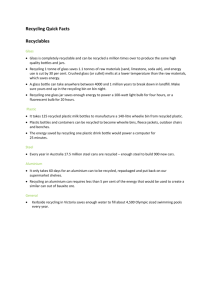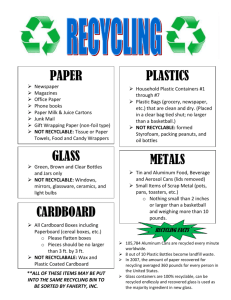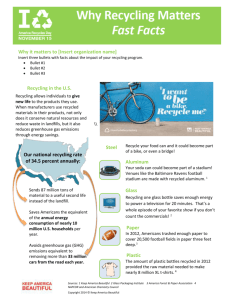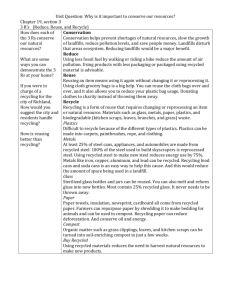Recycling Facts - Autodesk Design Academy
advertisement
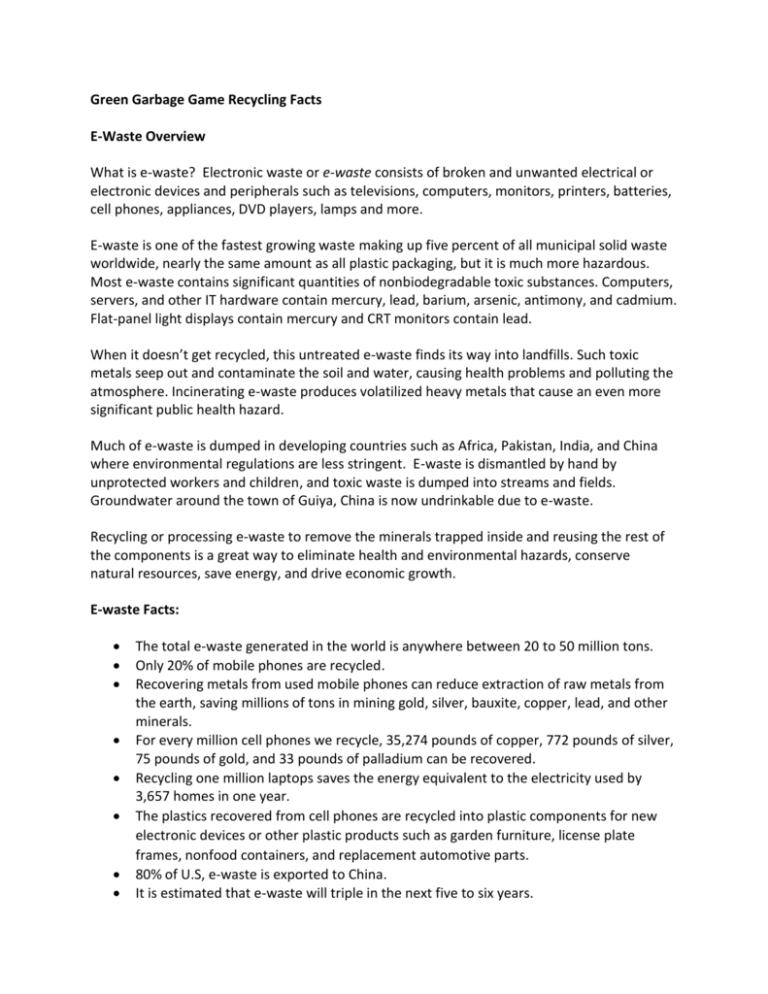
Green Garbage Game Recycling Facts E-Waste Overview What is e-waste? Electronic waste or e-waste consists of broken and unwanted electrical or electronic devices and peripherals such as televisions, computers, monitors, printers, batteries, cell phones, appliances, DVD players, lamps and more. E-waste is one of the fastest growing waste making up five percent of all municipal solid waste worldwide, nearly the same amount as all plastic packaging, but it is much more hazardous. Most e-waste contains significant quantities of nonbiodegradable toxic substances. Computers, servers, and other IT hardware contain mercury, lead, barium, arsenic, antimony, and cadmium. Flat-panel light displays contain mercury and CRT monitors contain lead. When it doesn’t get recycled, this untreated e-waste finds its way into landfills. Such toxic metals seep out and contaminate the soil and water, causing health problems and polluting the atmosphere. Incinerating e-waste produces volatilized heavy metals that cause an even more significant public health hazard. Much of e-waste is dumped in developing countries such as Africa, Pakistan, India, and China where environmental regulations are less stringent. E-waste is dismantled by hand by unprotected workers and children, and toxic waste is dumped into streams and fields. Groundwater around the town of Guiya, China is now undrinkable due to e-waste. Recycling or processing e-waste to remove the minerals trapped inside and reusing the rest of the components is a great way to eliminate health and environmental hazards, conserve natural resources, save energy, and drive economic growth. E-waste Facts: The total e-waste generated in the world is anywhere between 20 to 50 million tons. Only 20% of mobile phones are recycled. Recovering metals from used mobile phones can reduce extraction of raw metals from the earth, saving millions of tons in mining gold, silver, bauxite, copper, lead, and other minerals. For every million cell phones we recycle, 35,274 pounds of copper, 772 pounds of silver, 75 pounds of gold, and 33 pounds of palladium can be recovered. Recycling one million laptops saves the energy equivalent to the electricity used by 3,657 homes in one year. The plastics recovered from cell phones are recycled into plastic components for new electronic devices or other plastic products such as garden furniture, license plate frames, nonfood containers, and replacement automotive parts. 80% of U.S, e-waste is exported to China. It is estimated that e-waste will triple in the next five to six years. 68 % of consumers stockpile their used or unwanted computers at home. Over 112,000 computers are thrown away each day. E-waste Quiz: 1. 40% of cell phones are recycled. Answer: False 2. Most consumer-electronics are recycled locally. Answer: False 3. E-waste is the fastest growing municipal waste. Answer: True 4. E-waste includes computers, TVs, DVD players, VCRs, and lamps. Answer: True 5. Cell phones house valuable minerals such as gold and silver. Answer: True e-waste information sources http://www.brighthub.com/environment/green-computing/articles/71375.aspx http://www.businessinsider.com/theres-gold-in-those-trashed-cell-phones-2009-3 http://www.gartner.com/technology/home.jsp http://www.greenpeace.org/international/en/campaigns/toxics/electronics/the-e-waste-problem/where-does-ewaste-end-up/ http://www.repairlaunch.com/e-waste/e-waste-facts/ http://www.epa.gov/osw/conserve/materials/ecycling/faq.htm Compost Overview: Did you know that your leftover food scraps, paper, wood, and yard trimming can feed your soil? Yard trimmings, wood, paper, and food residuals together make up 243 million tons of the municipal, solid-waste stream in the United States. That’s a lot of leftovers and leaves! Composting occurs naturally: end of life supporting new life by returning into the soil again. Composting is a natural recycling process whereby tiny microorganisms and mini-beasts feed off decomposing kitchen and garden scraps. This helps to break down the organic matter. After six to nine months the rubbish will have turned into nutrient-rich, brown compost, ready for use on plants and soil. You can compost almost anything that was once alive, apart from cooked food, meat, fish, and waste of animal origin. These items can attract pests and vermin such as flies and rats. The great thing about composting is that it can happen anywhere, from a tiny city apartment to a big farm. Many cities strongly encourage and even require residents to set aside their yard waste and kitchen scraps for city composting programs. Composting has many benefits and it is free. It greatly reduces the amount of garbage created by each household, which means less waste sent to landfills. Experts estimate 25% to 50% of the food we purchase ends up being thrown away! That’s a lot of lost $$, waste, and a big impact on the environment. Composting is one of many environmentally friendly ideas that can also save you money. By composting your household organic waste, you can cut back on garbage bills while helping the earth. Composting also acts as a natural fertilizer. By mixing compost into the soil, you can bring nutrients back into the soil, or add top soil to help retain water and prevent erosion, and you can help reduce methane gas emissions. Composting can also help clean up contaminated soils and soils containing heavy metals. In fact, the Environmental Protection Agency (EPA) recommends composting to eliminate preservatives, pesticides, and chlorinated and nonchlorinated hydrocarbons found in contaminated soil. As yard trimmings decompose in landfills, they generate methane gas, a potentially explosive greenhouse gas that is released as organic materials decompose. As methane leaches into the ground, it has the potential to explode. Grasscycling returns grass clippings to your yard, reducing waste, mowing time, and the release of methane gas, while adding nutrients back into the earth. Say “No” to greenhouse gas and “Yes” to grasscycling! Composting is a great way for all households to have a direct effect on reducing waste and greenhouse gas, and feeding the soil. Put the benefits of composting to work for you by starting your own compost pile or participating in your city's composting program. Compost Facts: Composting helps control pollution by reducing greenhouse gas emissions and lessening pesticide use. Composting helps control erosion and polluted storm water from reaching water resources. Composting can help clean up contaminated soils. Mulching reuses so-called yard waste. Make mulch from chipped or shredded wood waste or dried leaves or grass clippings. These “green” items are ideal for composting. They are quick to rot and provide important nitrogen and moisture: grass clippings, vegetable and fruit scraps, coffee grinds and filters, tea bags, old flowers and plants, and animal manure with straw. These “brown” items are key to creating compost, providing carbon and fiber, and for allowing air pockets to form since they are slower to rot: paper, fallen leaves, straw, egg shells, egg cartons, hair, twigs, sawdust, and your Christmas tree. Keep these items out of your compost: meat, dairy, diseased plants, animal waste, coal and ash, and plastics. As much as 80% of the waste stream in low- and middle- income countries is compostable. Composting is free organic fertilizer, and can be started with very little capital and operating costs. The climate of many developing countries is optimum for composting. Composting addresses significant health effects resulting from organic waste such as reducing Dengue Fever. Composting accommodates seasonal waste fluctuations such as leaves and crop residue. Nearly six million tons of wood waste (for example, urban wood waste, woody debris from suburban land clearing, and rural forestry residuals) were generated in 2003 according to the EPA. Compost Quiz: 1. Composting is expensive and can be a hazardous to your health. Answer: False 2. Composting meats and diary is okay. Answer: False 3. Composting helps control diseases resulting from organic waste. Answer: True 4. Composting reduces greenhouse gases and pesticide use. Answer: True 5. Grasscycling is harmful to your lawn and results in greenhouse gas. Answer: False Composting information sources http://www.brighthub.com/environment/green-living/articles/67068.aspx#ixzz1GQhNldsy http://www.epa.gov/osw/conserve/rrr/composting/index.htm http://www.recyclenow.com/home_composting/making_compost/index.html http://www.novaquatis.eawag.ch/organisation/abteilungen/sandec/publikationen/publications_swm/downloads_ swm/composting_applicability.pdf Paper Overview: Paper makes up 40% of the waste stream! Think about that the next time you throw away a piece of paper! Paper is everywhere, from the paper you write on to newspapers and magazines, product packaging, boxes, posters, notebooks, and flyers. It’s something that we use every day, making it the top trash we throw away. That means for every 100 pounds of trash we throw away, about 35 pounds of it is paper! Each year, more than two billion books, 350 million magazines and 24 billion newspapers are published. Recycling one morning newspaper daily would save 41,000 trees from being cut down and would greatly reduce carbon emissions into the air. Paper recycling takes our old paper products such as newspapers, computer paper, magazines, cardboard, and paper packaging and turns it into recycled paper. Making paper from recycled paper uses 70% less energy than producing virgin paper. We create 35% less water pollution and 74% less air pollution when producing recycled paper. It takes 98 tons of resources to produce one ton of paper. By recycling one ton of paper, you save 17 trees. Recycled paper can be made into: New phone books Cereal boxes Animal bedding Mailing envelopes Home insulation Toilet paper Roofing shingles Paper towels Paper bags Newspaper Calendars Paper Facts: The average American uses seven trees a year in paper, wood, and other products made from trees. This amounts to about two billion trees per year! If every American recycled just one-tenth of their newspapers, we would save about 25 million trees a year. The amount of wood and paper we throw away each year is enough to heat 50 million homes for 20 years. Approximately one billion trees worth of paper are thrown away every year in the U.S. To produce each week's Sunday newspapers, a half a million trees must be cut down. Recycling a single run of the Sunday New York Times would save 75 thousand trees. If all our newspaper was recycled, we could save about 250 million trees each year and save 14% of landfill space. For every ton of newspaper recycled, you can save enough energy to power a television for 31 hours. In 2007, 35% of recovered paper was exported to overseas markets. About 62% stayed in the U.S. to be recycled into paper and paperboard products. The remainder was used to make other nonpaper products. Papermaking materials in the U.S. come from: Recycled paper: 33% Whole trees and other plants: 33% Wood chips and scraps from sawmills: 33% When you recycle paper, you allow more trees to thrive and supply us with healthy oxygen to breathe. Paper Quiz 1. Recycling newspapers would save 14% landfill space. Answer: True 2. A half a million trees need to be cut down to produce each week’s Sunday newspaper. Answer: True 3. The average America uses enough paper products in a year to equal one tree. Answer: False 4. Paper can be recycled up to two times. Answer: False 5. Recycled paper can be turned into egg cartons, newspapers, and home insulation. Answer: True Paper recycling information courtesy of: http://www.brighthub.com http://www.Treecycle.com http://en.wikipedia.org http://www.greenstudentu.com http://www.epa.gov http://www.ecy.wa.gov Plastics Overview: Plastics play an important role in almost every aspect of our lives. Plastics are used to manufacture everyday products such as beverage containers, toys, and furniture. The widespread use of plastics demands proper end-of-life management. Plastics make up more than twelve percent of the municipal solid waste stream, a dramatic increase from 1960, when plastics were only one percent of the waste stream. Like nearly all recyclables, except for paper and compost, plastic also takes a long time to break down in landfills, approximately 100 to 400 years. Plastic items are usually labeled with their recycling number, from one to six, indicating the variety of plastic used in it. Plastic Recycling Codes Code Name Description Examples polyethylene terephthalate usually clear or green, sinks in water, rigid, glossy semi-rigid, sinks in water Soda bottles, peanut butter jars, vegetable oil bottles. #1 plastic is easy to recycle and accepted in virtually all recycling programs Milk and water jugs, juice, and bleach bottles. #2 plastics are also very easy to recycle Detergent / cleanser bottles, pipes. PVC is used in shower curtains, children's toys, and fashion accessories, as well as some detergent and spray bottles. #3plastics are not recyclable. 6-pack rings, bread bags, sandwich bags. While curbside recycling doesn't usually accept #4 plastic, many large grocery chains accept shopping bags for recycling. Yogurt and deli take out containers, Tupperware and Rubbermaid food storage containers. Some recycling programs accept #5 plastic Styrofoam, packing peanuts, egg-cartons, foam cups, plastic silverware. Some recycling programs accept #6 plastic. Ketchup and syrup bottles and other items made up of more than one kind of plastic. It pretty much can't be recycled at all. PETE or PET HDPE high density polyethylene polyvinyl chloride semi-rigid, glossy, sinks in water low density polyethylene flexible, not crinkly PVC LDPE PP PS polypropylene polystyrene multi-layer plastics Other semi-rigid, low gloss often brittle, glossy squeezable The largest category of plastics is found in containers and packaging (for example, soft drink bottles, lids, shampoo bottles), but plastics are also found in durable (for example, appliances, furniture) and nondurable goods (for example, diapers, trash bags, cups and utensils, medical devices). The recycling rate for different types of plastic varies greatly. The percentages of PET and HDPE plastics are much higher than overall plastic recycling rates. Check with your local sanitary districts to see what plastic is accepted in your local recycling program, and better yet, avoid using plastic! Plastic Facts: 30 million tons of plastic waste was generated in 2009, representing 12.3% of total solid waste. In 2009, the United States generated 13 million tons of plastics as containers and packaging, almost 11 million tons as durable goods, such as appliances, and almost seven million tons as nondurable goods, for example plates and cups. Only 7% of the total plastic waste generated in 2009 was recovered for recycling. In the United States, 2.5 million plastic bottles are used every hour! Two thirds of them do not get recycled. Plastic bags and other plastic garbage thrown into the ocean kill as many as one million sea creatures every year! Recycling plastic saves twice as much energy as burning it in an incinerator would. In the United States, 25 billion Styrofoam coffee cups are thrown away every year Recovered plastic is remade into lots of cool things, such as park benches made of plastic lumber and fiberfill for ski jackets. Plastic Quiz: 1. Plastics can be recycled forever. Answer: False 2. All plastics can be recycled. Answer: False 3. The United States has the highest rate of plastic recycling in the world. Answer: False 4. Recovered plastics can be made into clothes and shoes and shopping bags. Answer: True 5. PET or PETE and HDPE plastics are the most commonly recycled types of plastic. Answer: True Plastic recycling information courtesy of: http://www.brighthub.com http://www.container-recycling.org/facts/all/ http://www.ecy.wa.gov/programs/swfa/kidspage http://www.epa.gov http://en.wikipedia.org Glass Overview: Glass, especially glass food and beverage containers, can be recycled over and over again. In fact, 90% of recycled glass is used to make new containers. Recycled glass can also be used in kitchen tiles, countertops, and wall insulation. Glass recycling has grown considerably in recent years because of increased collection through curbside recycling programs and glass manufacturers’ increased demand for recycled glass. Most glass manufacturers rely on a steady supply of crushed glass that is ready to be remelted, known as “cullet,” to supplement raw materials. To make glass, manufacturers mix sand, soda ash, limestone, and cullet; heat the mixture to a temperature of 2,600 to 2,800 degrees Fahrenheit; and mold it into the desired shape. Using cullet saves money and helps the environment, because: Cullet costs less than raw materials. Cullet prolongs furnace life and saves energy since it melts at a lower temperature. Less energy used means reduced emissions of nitrogen oxide and carbon dioxide, both greenhouse gases. Glass collected at the curbside is usually commingled, meaning that different colors and types of glass are collected together. This glass might then be sorted by color, or other characteristics, at a materials recovery facility. Some municipal and commercial recycling programs require participants to separate clear, brown, and green glass. Although all glass is made of silica and soda, the type and quantity vary slightly with different types of glass. Different melting points and chemical incompatibility make it important to sort glass by color. Glass separated by color yields glass cullet of higher economic value. Glass Facts: In the U.S., tens of millions of glass bottles and jars per year―enough glass products that could fill a skyscraper every two weeks! Most glass bottles and jars contain about 25% recycled glass. Like aluminium and steel, glass can be recycled forever! Communities that have enacted bottle deposit laws typically have about 40% less litter by volume. For every 2,000 pounds of glass that is recycled, we save more than 2,000 pounds of other resources (1,330 pounds of sand, 433 pounds of soda ash, 433 pounds of limestone, and 151 pounds of feldspar). The United States generated 11.8 million tons of glass in the municipal solid waste (MSW) stream in 2009. About 26% percent of the glass was recovered for recycling. A typical glass processing facility can recycle 20 tons of color-sorted glass per hour. Recycled glass has created glassphalt, which is much like asphalt and used in more and more regions of the world as an alternative material as well as a source for sand that is much needed at many beaches suffering from erosion. By the end of 2013, new glass bottles will be made from 50% recycled material. This step will save enough energy to power 45 thousand households for a year, and 181,550 tons of waste from landfills each month. The energy saved from recycling one glass bottle can power a computer for 30 minutes, a television for three hours, and a 100-watt light bulb for four hours or a compact fluorescent bulb for 20 hours! It also causes 20% less air pollution and 50% less water pollution than when a new bottle is made from raw materials. Glass Quiz: 1. Glass is made into glassphalt used to prevent beach erosion. Answer: True 2. Recycling one glass bottle can power a television for three hours. Answer: True 3. Glass can only be recycled once. Answer: False 4. Bottle deposits discourage people from recycling glass. Answer: False 5. Glass naturally breaks down and recycles in landfill. Answer: False Plastic recycling information courtesy of: http://www.brighthub.com http://www.container-recycling.org http://www.ecy.wa.gov http://www.epa.gov http://en.wikipedia.org http://www.ehow.com http://www.glassonweb.com http://www.ameriflowrecycling.com


